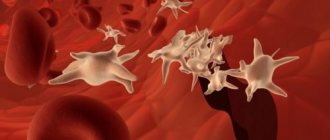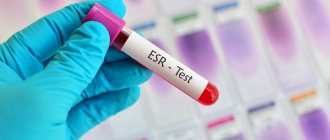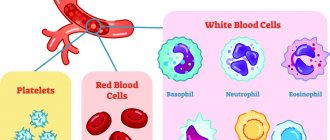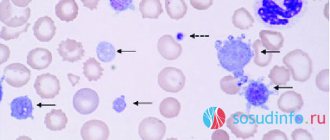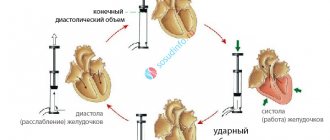MCV in a blood test is one of the most important erythrocyte indices. It reflects the average volume of a red blood cell and is calculated by dividing the hematocrit by the number of red blood cells. The result is expressed in cubic microns or femtoliters.
Another way to obtain this indicator is to multiply the hematocrit by 10 and divide the resulting number by the number of red blood cells contained in one cubic millimeter of blood.
It is important to consider that in some cases the mcv test will produce invalid data. For example, in sickle cell disease, large numbers of abnormal, misshapen red blood cells circulate in the bloodstream. Therefore, the indices obtained by calculation will in this case be uninformative.
What is average red blood cell volume?
In medicine, the average volume of erythrocytes is an indicator that reflects the amount of hemoglobin in red blood cells. Another term is also used for this designation - average corpuscular volume.
To calculate its value, use the following formula: experts multiply the percentage of hematocrit by ten, and the resulting number is divided by the number of red blood cells. The resulting value is the average red cell volume.
This indicator allows specialists to establish information about the size of red blood cells. This parameter is taken into account if the doctor needs to determine the type of anemia (normocytic, microcytic or macrocytic). In addition, the value is an additional method for diagnosing various disorders occurring in the human body.
If the value is higher, then they speak of the development of macrocytosis. With a decrease in MCV, the development of microcytosis begins. In both cases, the causes of such deviations are various pathologies. However, the person’s age and gender criteria are taken into account.
Definition of indicator and designation in analysis
To establish the value of the average volume of red blood cells, a blood test is performed. It is usually prescribed if anemia and other blood diseases are suspected, as well as to establish impaired water-electrolyte metabolism.
When close relatives have a history of severe blood pathologies, such an analysis needs to be carried out quite often, starting in infancy. However, in some cases the result may not be sufficiently reliable - this applies to patients who have a history of sickle cell anemia.
Also, determining the indicator is important before surgery. Patients undergoing chemotherapy or radiation therapy should be tested regularly. To determine the MCV level, a hemolytic analyzer is used - a modern laboratory device
This indicator is included in the transcript of the general blood test.
Typically, no special preparation is required to take such an analysis. However, experts recommend donating blood on an empty stomach, so it is best to do this in the early morning.
After drops of blood appear, it is collected with a device similar to a large pipette and poured into a test tube. The resulting blood is examined over several hours.
In the transcript of the analysis, the average volume of red blood cells is indicated by an abbreviation of Latin letters: MCV. The units of measurement are cubic micrometers (abbreviated µm3) and femtoliters (fl).
Normal indicator according to age criterion
The normal average volume of red cells depends on the age criterion. Thus, the following values in childhood are considered normal:
- Newborns – from 96 to 120 fl
- Per week – from 88 to 125 fl
- In one month – from 87 to 124 fl
- At two months – from 77 to 115 fl
- At six months of age - from 76 to 107 fl
- From one to 5 years – from 72 to 85 fl
- Up to 10 years – from 75 to 88 fl
- Up to 15 years – from 76 to 96 fl
For adults, the following indicators are considered normal values for red blood cell volume:
- Within 77-98 fl – for young people under 20 years old
- From 80 to 99 fl – aged 20 to 40 years
- From 80 to 101 fl – up to 65 years of age
- From 78 to 102 fl – after 65 years
Thus, after birth, children have slightly higher MCV levels than adults. After a year it decreases significantly.
In women under 45 years of age, the norm is 1-3 fl more than in men of this age. After 46 years, the indicator for patients of both sexes is from 81 to 102 fl. After age 65, the rate is usually lower.
How is the MCV blood test performed?
To determine the MCV level, you need to visit a laboratory that specializes in determining quality blood parameters, or take tests at a local clinic.
To obtain the most accurate diagnostic results with minimal risk of data errors, you will need to follow the rules for preparing for the donation of biological material, undergo the blood sampling procedure and wait for the test results.
Preparation
Includes the implementation of the following recommendations, which allow you to maintain the cellular composition of the blood at an optimal level without provoking its sudden changes.
The patient who will be tested will need to follow the following rules:
- 3 days before blood sampling, do not drink alcohol;
- take the test in the morning (preferably before 10-00);
- 2 days before diagnosis, exclude physical activity, do not engage in strength sports, do not lift heavy objects;
- have breakfast only after blood sampling, so that the stomach is empty (the best option would be to eat wheat, rice, pearl barley, barley porridge with vegetable salad).
It is recommended not to smoke 8 hours before donating blood. In the evening the day before the test, you should not overeat. All food consumed before laboratory testing should be light and not burden the digestive system.
Blood collection
A mandatory condition for submitting biological material for testing for MCV levels is taking blood on an empty stomach.
This procedure is performed using two methods, namely:
- ring finger bundle - pierced with an automatic pen with needles or a metal scarifier (about 1-2 ml of blood is taken by a laboratory assistant);
- ulnar vein — collection of biological material is carried out with a disposable syringe, which is filled with 5-10 ml of blood.
In order to obtain the most accurate research results, it is advisable to perform simultaneous collection of capillary and venous blood. This will allow for a comparative analysis of the selected samples, eliminating the possible occurrence of inaccuracies and errors in the operation of medical equipment.
How long to wait for answers
Modern medical equipment allows you to obtain laboratory test results for the MCV level within 15-20 minutes.
after delivery of biological material. In most cases, determining the average size of red blood cell units is only 1 of more than 20 parameters of the cellular composition of the blood that laboratory specialists need to determine.
If the staff of the clinic where the collected blood is tested uses automatic analyzers, the diagnostic process is significantly accelerated.
In laboratories that are not equipped with modern medical equipment and use microscopic research techniques, you will need to wait from 1 to 2 hours. In this case, the laboratory assistant performs an independent blood test, establishing the average volume of red blood cells using a microscope.
It is believed that the microscopic diagnostic method carries a greater number of errors, because there is a human factor involved. In order to save personal time and obtain the most accurate diagnostic results, it is recommended to donate blood in laboratories that are equipped with automatic analyzers.
Deviations from the norm
Average Er volumes may deviate from the norm; there are conditions in which the indicator of this test is:
- reduced – the average size of Er is less than 80 fl, Er is called microcytes;
- normal - the range of red blood cell sizes is 80 - 100, cells of this volume are called normocytes;
- increased - the average size exceeds 100 fL, and such Er macrocytes are called.
MCV reduction
When a large number of small red blood cells appear in the blood, this erythrocyte index will be reduced. Developing at low Wed volume. erythr. anemia is classified as microcytic.
A decrease in the average size of red blood cells is observed in anemia:
- iron deficiency;
- sideroblastic – immature Er with iron granules are found in the bone marrow (sideroblasts);
- associated with disorders of erythropoiesis - the process of Er formation; a hereditary form in men associated with impaired synthesis of porphyrins, a component of hemoglobin;
- acquired forms, provoked by a lack of vitamin B6, lead poisoning, impaired formation of porphyrins;
Hereditary and acquired anemia, associated with a decrease in the synthesis of porphyrins, is caused by the disruption of the production of hemoglobin molecules. Iron entering the body is not incorporated into the hemoglobin molecule, but is deposited in various organs.
The process of accumulation of unbound iron occurs predominantly:
- in the liver – a process starts that leads to cirrhosis of the liver;
- ovaries – sexual function is impaired;
- pancreas – diabetes mellitus is provoked;
- adrenal glands - hormone production is disrupted.
Anemia associated with blocking the synthesis of porphyrins is detected in young people. The disease is often unexpressed. This means that the symptoms of the disease are mild, and although a person’s average red blood cell volume is low, his iron content is high, and hemoglobin gradually drops, and can reach 50–60 g/l in an adult male.
This index is reduced in children with thalassemia, a hereditary disease that affects the genes encoding the synthesis of hemoglobin chains. If only one gene is affected, this means that the average volume of red blood cells will be slightly reduced, and the child may even be asymptomatic.
But if all 4 genes responsible for the synthesis of alpha-hemoglobin chains are affected, the fetus develops intrauterine hydrops and the child dies immediately after birth or in utero.
Increase in average volume indicators
If the average volume of erythrocytes is increased, this means that a lot of Er of large sizes have appeared, exceeding the norm. The appearance of macrocytes and an increase in the average volume of Er are observed in diseases:
- anemia; hemolytic;
- aplastic;
- folate deficiency;
- B12-deficient;
The average volume of erythrocytes and RWD in an adult with myelodysplastic syndrome are increased, which means that the number of macrocytes in the blood is increased and anisocytosis is observed - a phenomenon of high variability in cell sizes. With an increased average volume of Er in an adult and normal hemoglobin, it can be assumed that the person suffers from alcoholism.
The MCV of red blood cells may be slightly increased if a person smokes, and in women, an increase in the average volume is provoked by taking hormonal contraceptives.
Description of the analysis
The mcv value is calculated based on data obtained from a general blood test. This is one of the most widespread and frequently prescribed laboratory tests. It allows you to comprehensively assess the condition of the entire hematopoietic system.
Erythrocyte indices, which are part of a general blood test, allow one to diagnose and classify various anemias with fairly high accuracy. Thanks to this, the doctor will be able to make an accurate diagnosis and prescribe the correct treatment regimen.
Since the analysis is simple, inexpensive and publicly available, it is used as a screening technique for identifying disorders in the hematopoietic system. Another advantage of the technique is the possibility of dynamic monitoring of the effectiveness of the treatment and timely adjustment of the dosages of drugs prescribed to the patient.
The result of the study may be affected by the presence of severe leukocytosis, a large number of reticulocytes, and a significant excess of normal glucose levels. All these conditions lead to an increase in the average size of the red blood cell.
It should also be taken into account that a simultaneous increase in macrocytic (large) and microcytic (small) red blood cells can create the appearance of normality. This is due to the fact that mcv is a calculated indicator that does not always reflect the objective state of blood cells. To identify abnormalities in such cases, direct microscopy of a blood smear taken from the subject is required.
Reduced RDW pathology and norm
In a healthy person, red blood cells have the same shape, density and color. In cases of deviations, especially in autoimmune diseases and oncology, a malfunction occurs at the microcellular level when newly formed cells do not receive enough of certain components, and in fact are not able to perform their functions. This leads to anemia, a pathological condition in which the body does not receive the required amount of oxygen, that is, the metabolic function of red blood cells is disrupted.
The erythrocyte distribution index is determined during a general blood test. In some cases, if a specific disease is suspected, only this index can be determined in the analysis. In most cases, the RDW is determined together with the average MCV volume, since these indices (volume and quantity) are interrelated and help determine the type of anemia. The fact is that for a complete assessment of the condition of red blood cells, not only their shape is important, but also the quantity in the blood. And if elevated values occur with a frequency of 1 in 10,000 people, then decreased values occur extremely rarely and always indicate serious health problems.
A blood test to determine RDW can be performed both routinely (during medical examinations) and according to indications when there are suspicions of abnormalities in hematopoietic function. The analysis is mandatory before surgery, in childhood and during pregnancy.
Why is RDW needed?
As mentioned above, this index allows you to evaluate the qualitative composition of red blood cells, taking into account their dimensions.
But what does this give? The fact is that red blood cells are similar to each other, like twin brothers, which allows them to replace each other at the right time or stick together into blastulas. If cells increase in size, their need for nutrition also increases, and accordingly their life expectancy is short. This in turn affects the overall level of red blood cells in the blood and human health.
The more cells die, the more bilirubin and iron are released, which in turn places an increased burden on the liver, which will malfunction and cannot cope with the processing of these substances.
The RDW index is directly related to anisocytosis, a pathological process in which the shape of red blood cells changes, which affects their volume and size. Anisocytosis is a complex chemical process that affects all blood cells.
We invite you to watch a video on the topic
How is it determined?
The erythrocyte distribution index is calculated as a percentage, the norm of which varies from 11.5 to 14.8.
It is determined using a mathematical formula, in the form of the ratio of modified red blood cells exceeding the maximum permissible volumes to the total mass of red blood cells.
Today, laboratories use computer technology to determine the percentage of deviation from the norm without manual calculations. The output data is presented in the form of a histogram, which displays a curve indicating possible modifications of red blood cells.
What do the results depend on?
Norms are determined depending on age, gender and the presence of physiological processes occurring in the body. For children in the first year of life, the norm is considered to be 11.5-18.7%. After a year, the digital values tend to the generally accepted norm - 11.5-14.5%. In women, the upper limit may shift to 15.5%, which is explained by frequent changes in hormonal levels: pregnancy, breastfeeding, taking hormonal contraceptives, menopause.
Blood is taken in the morning (before 9 am) on an empty stomach
It is important that before blood sampling the person does not take any medications and is in a balanced state
Index Variations
For a more detailed in-depth study of the erythrocyte distribution index, two values are considered:
- RDW-SD - determines the standard deviation from the norm, expressed in femtoliters. The indicator is in no way related to MCV, since it shows the quantitative value of the difference between the largest and smallest cells.
- RDW-SV - shows how much the volume of red blood cells differs from the average. It is defined as the percentage of all deformed cells to the total red blood cell mass.
Preparing for analysis
In most cases, blood for analysis is taken from a vein. It is permissible to take capillary blood from children under 3 years of age and from adults for special indications. The analysis is taken in the morning, on an empty stomach; the fasting period should be at least 8 hours.
Before blood sampling, it is forbidden to eat food or any drinks; you can drink plain water. There is no need to follow a diet a few days before the test, but you should exclude alcoholic drinks and fatty foods. It is undesirable to be exposed to high physical and psycho-emotional stress, which may affect the reliability of the analysis results.
In the process of preparing for the blood sampling procedure, the patient should be warned about possible unpleasant sensations when applying a tourniquet and during vein puncture.
Average hemoglobin concentration in erythrocyte
This parameter is designated as MCHC and expresses how full the red blood cells are with hemoglobin. MCHC characterizes the density of filling a red blood cell cell with hemoglobin.
Calculated as follows:
MCHC = Amount of hemoglobin * 100/Hematocrit. Hematocrit is the ratio of plasma volume to red blood cell volume. It is usually directly proportional to the total volume of red blood cells and is measured in g/dL, just like the amount of hemoglobin in general.
The MCHC norm varies depending on gender and age, but in general it can be said that for men it is 324-366 g/l, and for women 323-356 g/l. In childhood, the minimum limit for the average concentration of hemoglobin in an erythrocyte is reduced. So, for example, for a child up to 1 month old, MCHC = 280-260 g/l. All normal indicators should be checked with a doctor, especially for children, when literally every month the body works in a new way.
If the mean concentration of HB in MCHC red blood cells is increased, there is a possibility of an imbalance in the blood and the presence of hyperchromic anemia.
In general, even if the average hemoglobin concentration in a red blood cell is increased, it cannot exceed 380 g/l. This phenomenon can be explained from a chemical point of view: hemoglobin does not dissolve in water infinitely, but upon reaching a certain density threshold it begins to crystallize, which can lead to hemolysis of red blood cells.
So an overestimated analysis result may be an experimental error or an inaccurate calculation.
If the average concentration of hemoglobin in red blood cells is reduced, the reasons should be sought in hypochromic anemia. But this is not the only disease that can affect blood tests. In addition, the average hemoglobin content in a red blood cell is reduced if the patient has the following abnormalities:
- Anemia caused by lack of iron;
- Disorders of blood balance and metabolism;
- Deviations in hemoglobin synthesis;
- Macrocytic, sideroblastic anemia;
- Hemoglobinopathy.
As you can see, the average concentration of hb in the erythrocyte is reduced in various forms of anemia and disorders of the blood composition.
A large number of red blood cells in a child
High erythrocyte counts in children, in the case of true erythrocytosis, indicate the development of the disease.
But the child’s body reacts more acutely to the influence of external or internal non-pathological factors and a temporary increase in the number of red blood cells is caused by:
- teething;
- lesson in the sports section;
- recent cold infections.
Erythrocytosis often develops in children due to passive smoking.
Memo to parents. Even if it seems that the increase in the red blood cell count is associated with sports training or teething, there is no need to postpone a visit to the pediatrician; a repeat blood test should be performed as soon as possible. This will help identify an incipient disease in a child or exclude the development of pathology.
Increased value
If the average volume of red blood cells is increased, this may mean a disruption in the body’s functioning. Reasons when mcv is elevated can be:
Liver disease.
Defect in the functioning of red bone marrow.
The thyroid gland does not produce enough hormones;
Vitamin B12 deficiency. This deficiency has a particularly negative effect on children under 2 years of age. At this age, you need to focus on eating foods containing high amounts of vitamin B12, for example, sour cream, eggs, liver, beef and others.
Folic acid deficiency.
Smoking. Smoking releases a significant amount of carbon dioxide, which impairs blood transport in the body, leading to a deterioration in oxygen supply. Women who smoke are more susceptible to respiratory diseases, which can cause increased red blood cell counts.
Oncological diseases.
Taking contraceptive and hormonal medications.
Inflammatory processes in the body. These can be infectious diseases caused by a virus or some kind of fungus.
Alcoholism. In this case, the mcv indicator can be brought back to normal; to do this, it is enough not to drink alcohol for 100 days. It is worth saying that in this case only mcv values increase, and the hemoglobin value remains within normal limits.
There is a version that taking antidepressants for a long time can lead to increased levels, but at the moment this version is under study.
An increase in red blood cells in the blood may be temporary and not carry any abnormalities or pathologies. This situation can lead to:
stress;
being in high mountains;
excessive mental or physical work;
influence of toxins;
dehydration.
After these factors are eliminated, such important indicators of red blood cells as their average volume will return to normal.
RDW standards
Normally, the relative spread width Er RDW-SD is constant and amounts to 37 – 47 fl. A pathological deviation in the size of erythrocytes from the norm or anisocytosis is noted when RDW-SD values are more than 60 fL.
On the histogram, this means that the value of the relative width of the volume distribution is increased if the spread of erythrocytes in the sizes of the smallest and largest Er on a straight line drawn along the OY axis at the level of 20% is greater than 60 fl.
Norms for the coefficient of variation of erythrocytes RDW-CV - volume distribution width, table.
| Age categories | RDW-CV (percentage) |
| children up to ½ year old | 14.9 to 18.7 |
| children over ½ year old | 11.6 to 14.8 |
| adults | 11.5 to 14.5 |
The normal distribution width of erythrocyte cells changes during pregnancy and is by trimester:
- in the first – 11.7 – 14.9%;
- in the second – 12.3 – 14.7%;
- in the third – 11.4 – 16.6%.
The RDW-SD indicator is characterized by increased sensitivity to the appearance of microcytes. RDW-CV exhibits particular sensitivity to anisocytosis, the occurrence of deviations in the size of Er blood.
The level of anisocytosis of a blood sample reflects the heterogeneity (variability) of red blood cells in size.
There are different degrees of anisocytosis:
- The first – 30 – 50% Er deviate in size from the norm.
- The second – 50 – 70% of transformed cells.
- Third – more than 70% of Er deviate from the standard.
Analysis transcript
Red blood cell RDW indices obtained when processing a sample with hematological automatic analyzers are necessary for early diagnosis:
- deficiency of Fe, folate, vitamin B12;
- types of anemia;
- morphology of erythrocytes - structural features and sizes;
- myeloproliferative diseases affecting the bone marrow.
Decoding of the analysis data is carried out taking into account all erythrocyte indices. When interpreting the distribution width Er, the MCV value is of particular importance.
Raising RDW
The index of erythrocyte volume distribution is increased in anemia caused by B12 deficiency, and this means that the number of macroerythrocytes in the blood is increased, and the histogram is shifted to the right.
If the volume distribution width is increased, but the erythrocyte index such as MCV is increased, we can assume:
- hemolytic anemia;
- B12 deficiency;
- cold agglutination is a disease associated with the appearance in the blood of antibodies that glue red blood cells to each other in response to the action of cold.
Increased RDW (wide distribution of erythrocytes) and increased MCV in liver diseases, anemia caused by lack of vitamin B9.
An increase in the distribution width with a reduced index of average erythrocyte volume is observed in diseases:
- thalassemia;
- iron deficiency.
An increase in the Er spread width with normal MCV values may indicate:
- for a lack of vitamins B9 and B12;
- on the development of iron deficiency.
With increased values of the distribution width in the blood, accelerated destruction of red blood cells occurs, which is why the liver and spleen work at the limit of their capabilities. This leads to disruption of their functions, which manifests itself:
- the appearance of excess bilirubin;
- high Fe content;
- enlarged spleen.
Lower RDW
A decrease in the volume distribution width of Er means that there are cells of similar sizes in the blood. The boundaries of the spread of the RDW-CV value are narrowed in the following cases:
- oncological diseases - myeloma, leukemia;
- hemolysis - destruction of red blood cells;
- injuries with significant blood loss;
- deficiency of iron, B vitamins.
When RDW-CV decreases to 10.2%, macrocytic or microcytic anemia is suggested. In these forms of the disease, red blood cells are predominantly increased or decreased in size compared to the norm.
Microcytic anemias include iron deficiency, iron saturation, and iron redistribution. Macrocytic anemia develops with hypothyroidism, pregnancy, liver disease, hematopoietic disorders in the bone marrow, lack of copper, vitamins B12, and folic acid.
Not without nuances
An increased volume of red blood cells can be caused by:
- Cold autoagglutination (to eliminate this factor, the sample should be kept at a temperature of +37ºС in a thermostat);
- Diabetic ketoacidosis (plasma hyperosmolarity causes a rapid increase in the volume of red blood cells and, accordingly, macrospherocytosis when the blood is exposed to the analyzer solution during dilution).
We must not forget that a reduced MCV indicator does not always reflect the true picture of the blood, for example, with consumption coagulopathies or with mechanical damage to red blood cells with destruction and subsequent hemolysis, the MCV will be reduced (this effect is ensured by fragments of red cells present in the blood).
What does MCV in the blood mean and what is its norm?
Red blood cells, like other blood elements, perform their functions in the body. Red blood cells are responsible for supplying organs with oxygen and carbon dioxide, transporting enzymes, lipids and amino acids, regulating acid-base balance, adsorbing toxins and antibodies, and participating in the dissolution of blood clots. Any significant changes in their qualitative and quantitative characteristics signal pathological processes.
The morphological parameters of these elements are assessed using such calculated values as erythrocyte indices. One of them is MCV. So in a blood test, the average volume of red blood cells is indicated, and it is measured in femtoliters or cubic micrometers, respectively - fl or µm³.
MCV is one of the indicators of the state of red blood cells and is determined during a general analysis. It allows you to obtain more accurate and objective results regarding the volume of red blood cells, compared to visual assessment during conventional microscopic examination. It is calculated by dividing the hematocrit value (the volume of blood per red blood cells in 1 mm³) by the total number of red blood cells. The average volume value will not be reliable if there are a large number of red cells with different sizes and different shapes.
Norm
MCV is not a constant value, it changes with age and depends on gender. The maximum normal value of the average volume of red cells is observed in newborns - 90-140 fl. By one year, MCV changes to 71-84 fl; in the period from 5 to 10 years it is 75-87 fl. At the age of 15-18 years, the volume of red blood cells in women reaches 78-98 fL, in men - 79-95 fL. From 18 to 45 years old - 81-100 fl for women, 80-99 fl for men. From 45 to 65 years - 81-101 fl in women and men. At the age of 65 years and older, the normal MCV ranges from 81 to 103 fL.
If the red blood cells in the analysis are normal, they are considered normocytic; if the value is below 80 fL, the condition is called microcytosis; if the MCV is above 100, it is called macrocytosis.
Purpose of analysis
MCV is used to differentiate anemia. This indicator is important for the doctor because it confirms the hematological problem and allows you to determine the type of anemia.
In addition, the average volume of red blood cells determines the development of water and electrolyte balance disorders in the body. If red blood cells are low, this may indicate dehydration (hypertensive dehydration). If they exceed the norm, this indicates another type of dehydration - hypotonic.
Analysis transcript
Decoding the blood test result is the responsibility of the attending physician. If the MCV is increased or decreased, this suggests the presence of any diseases. In this case, a repeat analysis and other examinations are prescribed.
Based on the MCV value that red blood cells have, different types of anemia are distinguished: normocytic, microcytic and macrocytic.
Modern blood analyzers provide more accurate and objective results than examination under a microscope
If MCV is within normal limits, we are talking about the development of normocytic anemia, which includes the following:
- hemolytic,
- aplastic,
- hemorrhagic,
- anemia due to liver diseases,
- hepatic,
- anemia due to endocrine pathology.
Check out the article:
If red blood cells have an increased average volume, this indicates macrocytic anemia and other pathologies, including:
- vitamin B12 deficiency;
- folate deficiency, megaloblastic and pernicious anemia;
- hypothyroidism;
- intestinal diseases;
- liver diseases;
- decreased pancreatic function;
- bone marrow diseases;
- drug intoxication;
- alcoholism.
The average red blood cell volume may increase slightly in smokers and in women taking hormonal contraceptives.
If the MCV is lowered, then this indicates microcytic anemia, which is caused by the following factors:
- chronic diseases;
- iron deficiency;
- malignant tumors;
- lead poisoning;
- decreased production of hemoglobin (thallasemia);
- taking certain medications.
Video about the types and symptoms of anemia:
Conclusion
MCV analysis makes it possible to more accurately determine the average volume of red cells, in contrast to microscopic studies. The diagnostic value of this indicator lies in the ability to differentiate different anemias.
Increased sedimentation rate (ESR) in women and men
This indicator is measured in mm/h and it indicates the speed at which plasma is separated from the red blood cell mass. For an adult man and a woman, the norms are approximately the same: 2-20 mm/h.
What is he talking about?
When the erythrocyte sedimentation rate is elevated, what this means is determined individually, taking into account other blood parameters and the general condition of the patients.
Normally, red blood cell aggregation occurs slowly and by the end of the hour only a small light strip of pure plasma is visible in the capillary pipette with divisions. An increase in ESR almost always indicates a pathological process:
- viral or bacterial inflammation;
- necrosis and tissue breakdown;
- systemic diseases (rheumatism, vasculitis);
- hormonal abnormalities (diabetes, hyperthyroidism);
- oncology;
- gastrointestinal pathologies;
- allergic manifestations;
- condition after surgical treatment.
Causes of increased ESR in women are not always associated with the development of the disease. In the fairer sex, the erythrocyte sedimentation rate can increase:
- menstruation;
- pregnancy (up to 45 mm/h is considered normal);
- condition after childbirth;
- taking hormonal contraceptives.
If the doctor is not a gynecologist, then some ladies consider the doctor’s questions about menstruation or the use of contraceptives to be insensitive, but this information is necessary to determine why a woman has an elevated ESR.
In representatives of the stronger sex, an increase in values occurs when taking steroid drugs to build muscle mass.
When ESR is elevated in women or men, what this means is determined through additional examination. Even when an adult does not complain and there are no signs of disease development, during an external examination it is impossible to exclude the latent course of the disease or the initial stage of oncology.
How to reduce?
Before you try to lower, you should talk to your doctor about what it means if your ESR is high.
The reasons that cause an increase in women are not always pathological in nature. If red blood cell sedimentation is caused by pregnancy or menstruation, then the values will normalize on their own.
It is important to remember: an increase that occurs in an adult is not a disease, but only indicates that pathological changes are occurring in the body. The ESR will decrease after the disease is cured.
Therapy is prescribed to eliminate the cause of increased erythrocyte sedimentation:
- Infections are treated with antibacterial and antiviral agents.
- Foci of necrosis are excised surgically, and then antibiotic therapy is prescribed.
- In case of pathological changes in hormone levels, hormonal correction is indicated.
- Allergic reactions are treated with antihistamines.
- Treatment methods for cancer are selected taking into account the stage of tumor development. In the early stages, surgery is performed, and in advanced forms, the growth of cancer cells is suppressed using chemotherapy.
After reducing the severity of the pathological process, the ESR will gradually decrease.
During treatment, patients are given a test several times to determine the rate of separation of red blood cells from plasma. The study is necessary to monitor the effectiveness of therapy and to select other drugs.
Diseases with normal MCV
With normal test values, the development of such pathological conditions as:
- hemolytic anemia caused by: autoimmune process;
- spherocytosis;
- G6PD enzyme deficiency;
A hereditary deficiency of the enzyme glucose-6-phosphate dehydrogenase can cause hemolytic nonspherocytic anemia if the carrier of this genetic disorder begins to take medications or foods with oxidizing properties, which include:
- medications – norsulfazole, biseptol, urantoin, quinine, isoniazid;
- fava beans.
Increasing MCV parameter values
Often, any disturbances occurring in the body are directly reflected in blood tests. One of the common deviations from the norm is an increased MCV parameter. In this case, patients exhibit severe symptoms, for example, pallor or yellowing of the skin in the area of the nose and lips, too rapid heartbeat even in a state of complete calm of the patient. One of the signals of deviations from the norm can also be causeless unpleasant pain in the abdominal area.
An increased value of the MCV parameter can be observed in the following cases:
Lack of vitamin B12 in the body. This vitamin is directly responsible for the creation of DNA molecules, as well as the formation of red blood cells. Their number is rapidly decreasing, while the volume of red blood cells is growing. The hemoglobin level in each red blood cell is significantly increased due to the increased size of the red cells. In order to raise the level of vitamin B12 in the blood and lower the MCV value to normal values, it is necessary to eat foods rich in it.
- Poisoning with exogenous substances. Most often, this is a person’s use of alcoholic substances, as well as work in hazardous enterprises. Increases the average volume of red blood cells and the use of hormonal contraceptives. In order for the parameter to quickly return to normal, you need to stop taking these substances.
- Presence of myxedema (thyroid disease)
Comparative study
To ensure a comparative study on MCV, simultaneous sampling of capillary (ring finger) and venous blood is performed.
The laboratory specialist places both samples into the analyzer and, based on the diagnostic results, checks the data obtained. This research method makes it possible to eliminate the factor of incorrect operation of medical equipment and minimize the likelihood of obtaining a false result.
Reasons for increasing MCV
A violation of the MCV norm in the direction of an increase in the average cell size may indicate the occurrence of blood diseases or indicate a pathological condition of internal organs.
The following reasons for increased MCV in the bloodstream are identified:
- intoxication of the body with antibacterial drugs or medications included in the group of antidepressants;
MCV in blood tests increases with illness - bacterial infection that caused extensive inflammation;
- uncontrolled use of steroid drugs or contraceptives based on synthetic hormones;
- severe liver diseases in the form of cirrhosis, viral or intoxicating hepatitis;
- long-term use of strong alcoholic drinks;
- autoimmune pathologies, which are expressed in disruption of the process of red blood cell synthesis;
- prolonged contact with chemicals of toxic etiology, the compounds of which saturate the blood;
- iron and iodine deficiency in the body caused by poor diet or other factors;
- diseases of the thyroid gland associated with insufficient or excessive synthesis of hormones.
Most patients with MCV levels exceeding the norm experience characteristic symptoms in the form of causeless pain in the abdominal cavity, pale skin (if liver pathology is present, yellowing of the skin and whites of the eyes is possible), increased heart rate, and shortness of breath.
At risk are people who lead a sedentary lifestyle, as well as those with a genetic predisposition.
Reasons for the decrease in the indicator
A decrease in the average size of erythrocyte units is no less dangerous than an increase in blood cell parameters. The internal organs and tissues of the body begin to experience an acute lack of nutrients, oxygen starvation of cells and premature death occurs. A person quickly loses weight, and dysfunction of internal organs and systems develops.
The reasons for the decrease in MCV are the following factors:
- porphyria or a hereditary predisposition to the body producing defective cells;
- heavy metal poisoning (most often a similar clinical picture occurs in people who have been in contact with lead vapor);
- the presence of cancer of the blood or internal organs;
- severe dehydration of the body;
- long-term use of medications, the side effect of which is a decrease in the average volume of red blood cells;
- anemia of all types.
People who have a low MCV complain of constant fatigue, loss of physical strength, become absent-minded, cannot concentrate, and the thought process is disrupted.
The nervous system exhibits symptoms such as increased irritability, depression, rapid mood swings, and memory impairment. If these signs appear, you should consult a doctor as soon as possible.
Classification and causes of microcytic (MCV lowered) anemia
Anemia is a group of diseases of the human circulatory system, which is expressed in a decrease in hemoglobin levels, as well as a reduction in the average volume of red blood cells.
This pathology is classified according to the causative factors that provoked its development, namely:
- allastic - caused by systemic dysfunction of the bone marrow, as a result of which the process of synthesis and maturation of blood cells is disrupted;
- iron deficiency - there is a decrease in the rate of hemoglobin production, since the patient’s body does not receive enough iron;
- thalassemia is a hereditary type of anemia that occurs due to the fact that the body is not able to form sufficiently strong polypeptide bonds in the protein compounds of hemoglobin;
- hemolytic - develops when the level of dead cells exceeds the number of new red blood cells.
A type of microcytic anemia is taken into account by the attending physician when making a diagnosis, as well as during the formation of a therapeutic course. Eliminating the pathological causes of the disease is a prerequisite for successful treatment.
Cell Variability
Under the constant influence of a number of environmental factors, the occurrence of biochemical and physiological adaptation of blood cells cannot be ruled out.
Variability in the average volume of red blood cells is possible under the following conditions:
- prolonged abuse of alcoholic beverages (alcohol addiction);
- daily contact with toxic substances;
- eating excess amounts of protein foods;
- deficiency of foods containing iron and vitamin B12.
Sooner or later, physiological variability of cells leads to the development of diseases of the blood, as well as tissues of internal organs that suffer from an increased or decreased MCV. Most often, the pathological state of cells leads to the development of blood cancer.

